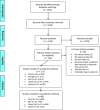Understanding the Impact of Rainfall on Diarrhea: Testing the Concentration-Dilution Hypothesis Using a Systematic Review and Meta-Analysis
- PMID: 33284047
- PMCID: PMC7720804
- DOI: 10.1289/EHP6181
Understanding the Impact of Rainfall on Diarrhea: Testing the Concentration-Dilution Hypothesis Using a Systematic Review and Meta-Analysis
Abstract
Background: Projected increases in extreme weather may change relationships between rain-related climate exposures and diarrheal disease. Whether rainfall increases or decreases diarrhea rates is unclear based on prior literature. The concentration-dilution hypothesis suggests that these conflicting results are explained by the background level of rain: Rainfall following dry periods can flush pathogens into surface water, increasing diarrhea incidence, whereas rainfall following wet periods can dilute pathogen concentrations in surface water, thereby decreasing diarrhea incidence.
Objectives: In this analysis, we explored the extent to which the concentration-dilution hypothesis is supported by published literature.
Methods: To this end, we conducted a systematic search for articles assessing the relationship between rain, extreme rain, flood, drought, and season (rainy vs. dry) and diarrheal illness.
Results: A total of 111 articles met our inclusion criteria. Overall, the literature largely supports the concentration-dilution hypothesis. In particular, extreme rain was associated with increased diarrhea when it followed a dry period [incidence rate ratio ; 95% confidence interval (CI): 1.05, 1.51], with a tendency toward an inverse association for extreme rain following wet periods, albeit nonsignificant, with one of four relevant studies showing a significant inverse association (; 95% CI: 0.771, 1.08). Incidences of bacterial and parasitic diarrhea were more common during rainy seasons, providing pathogen-specific support for a concentration mechanism, but rotavirus diarrhea showed the opposite association. Information on timing of cases within the rainy season (e.g., early vs. late) was lacking, limiting further analysis. We did not find a linear association between nonextreme rain exposures and diarrheal disease, but several studies found a nonlinear association with low and high rain both being associated with diarrhea.
Discussion: Our meta-analysis suggests that the effect of rainfall depends on the antecedent conditions. Future studies should use standard, clearly defined exposure variables to strengthen understanding of the relationship between rainfall and diarrheal illness. https://doi.org/10.1289/EHP6181.
Figures


References
-
- Alexander KA, Heaney AK, Shaman J. 2018. Hydrometeorology and flood pulse dynamics drive diarrheal disease outbreaks and increase vulnerability to climate change in surface-water-dependent populations: a retrospective analysis. PLoS Med 15(11):e1002688, PMID: 30408029, 10.1371/journal.pmed.1002688. - DOI - PMC - PubMed
-
- Aminharati F, Dallal MMS, Ehrampoush MH, Dehghani-Tafti A, Yaseri M, Memariani M, et al. 2018. The effect of environmental parameters on the incidence of Shigella outbreaks in Yazd province, Iran. Water Supply 18(4):1388–1395, 10.2166/ws.2017.205. - DOI
Publication types
MeSH terms
Grants and funding
LinkOut - more resources
Full Text Sources
Medical
Miscellaneous

